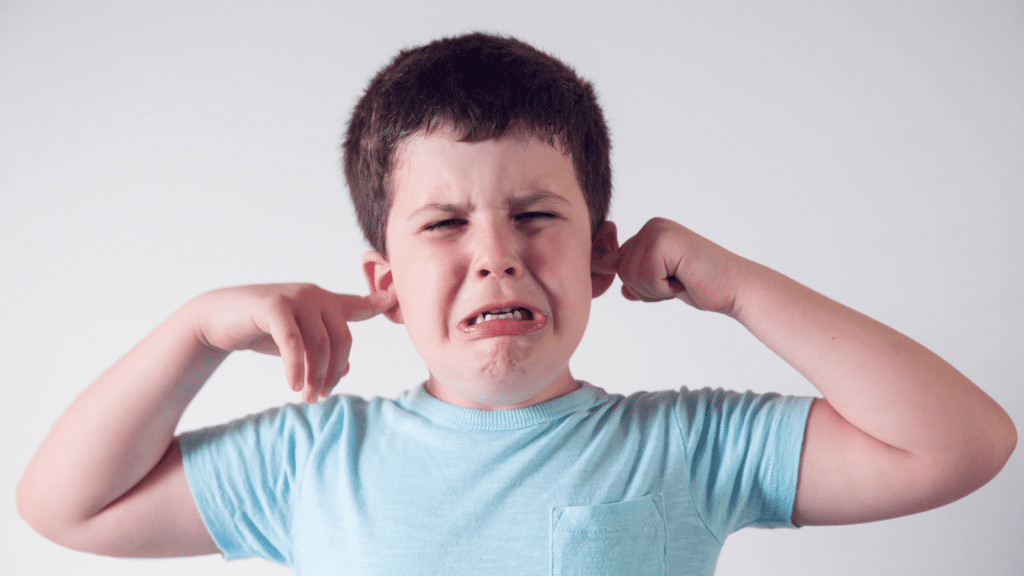Jake cuts the tags from all his t-shirts because it irritates him. He also picks clothes that are cotton only, including pants. His mother says he never wears jeans or denim. Instead, he prefers dress pants with a softer fabric.
Missy covers her ears whenever her mother uses the vacuum cleaner. One time, her mother found the hairdryer in the laundry hamper. Missy confessed she put it there.
Luca gags every time he eats some mashed potatoes or pureed food. He much prefers crunchy food.
Jake is over-sensitive to touch, while Missy is over-sensitive to sound, and Luca is sensitive to food texture. They all three have autism.
Is your child like Jake or Missy or Luca?
Many people with autism have difficulties processing information from their senses. Over 90% of children with autism have a form of sensory processing abnormality. Hearing and touch are the most affected senses.
The specific conditions include auditory filtering and touch sensitivity. Auditory processing problems may also worsen among children with autism and coexisting ADHD as they often have difficulty in dealing with busy backgrounds and noisy places such as schools, shopping centres.
It is significant to consider auditory processing therapies as an additional intervention for your child. The Tomatis® Method works with occupational and speech therapists to manage symptoms of sensory processing disorder and autism.
Before we get into how the Tomatis® Method can help your child, it’s better to understand the link between sensory processing disorder and autism.
- What is sensory processing disorder?
- Are Autism and Sensory Issues the same?
- How is sensory processing disorder different from autism?
- What is the relationship between Autism and Sensory Issues?
- How does the Tomatis® Method work for Autism and Sensory Issues?
- How will I know what works best for your child?
Grab our complimentary 20-min phone chat with Francoise Nicoloff
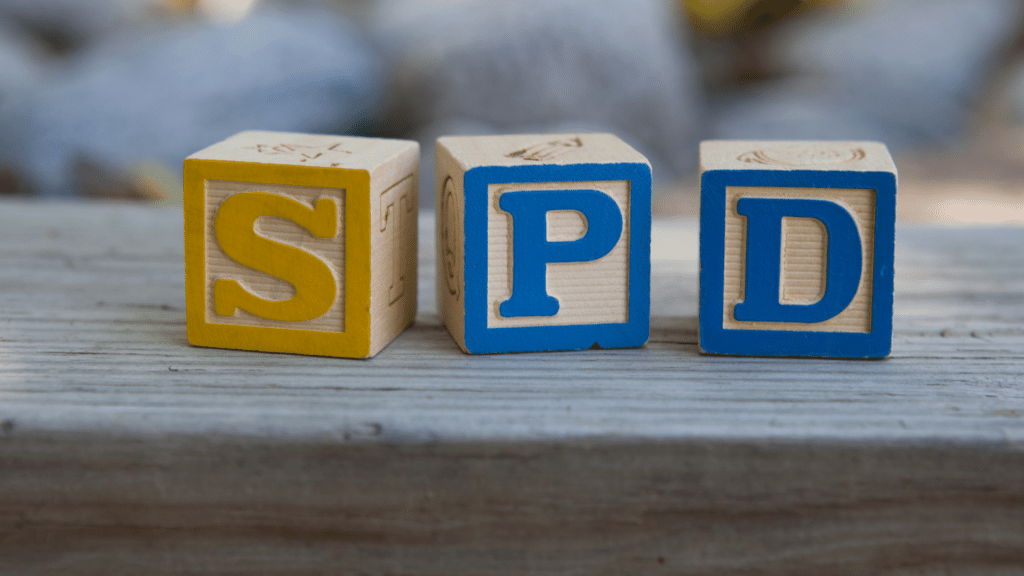
What is Sensory Processing Disorder?
Sensory processing refers to how the peripheral nervous system manages information from the eyes, ears, nose, tongue, and skin. It includes proprioception or the body’s awareness of position and movement. And the vestibular system in the inner ear plays a role in balance, coordination, muscle tone and sensory integration, amongst other ones.
There are three types of sensory processing disorders:
- Sensory modulation disorder is the difficulty in regulating the intensity and level of reaction to sensory inputs. It may be under-or over-responsiveness and sensory-seeking. It is most common in children with autism.
- Sensory discrimination disorder refers to the problem in perceiving and distinguishing sensory information. The brain is confused with the sensory stimuli which affect the eight senses:
- Touch/tactile
- Gustatory/oral
- Olfactory/smell
- Auditory/hearing
- Visual/sight
- Vestibular/balance
- Proprioception/body awareness
- Interoceptive/gut/internal organs
- Sensorimotor integration disorder is the difficulty in converting sensations into motor or physical actions. An example is dyspraxia. A person has problems with ideation and motor planning and may find it hard to learn new motor skills.
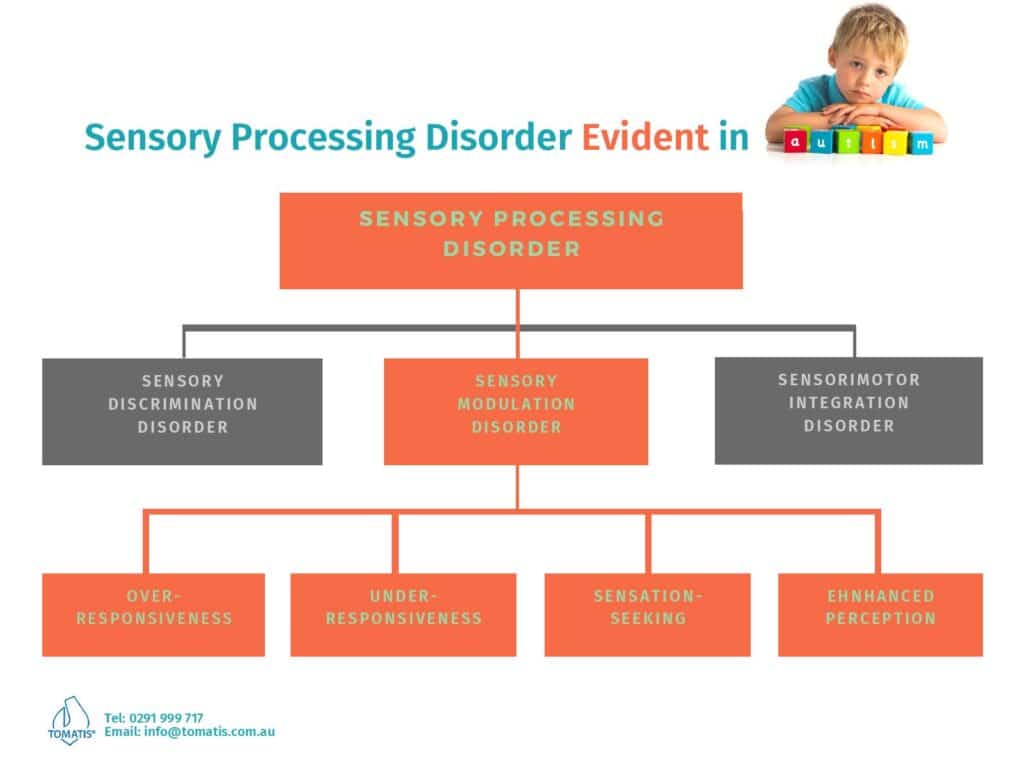
Are Autism and Sensory Issues the Same?
Sensory symptoms form part of autism diagnosis in the 2013 Diagnostic and Statistical Manual of Mental Disorders (DSM-5). Atypical sensory processing is considered a feature of autism. The specific condition related to autism is sensory modulation disorders.
Four types of sensory modulation disorders:
- A child with sensory under- or hypo-responsiveness may be slow to respond to stimuli. For instance, your child may have pricked his/her finger and does not immediately show pain.
- In contrast, a child with sensory over-or hyper-responsiveness may have exaggerated reactions to stimuli. For example, your child may be irritated by a particular fabric or clothing due to its texture.
- Sensory-seeking behaviour refers to unusual cravings or interests with specific sensory stimuli. Your child may eat inedible things or sniff certain body parts. Your child may find excitement when exposed to particular colours, lights, smells, sounds, tastes, and movements.
- Enhanced perception is when a child notices slight differences in visual inputs. Or a child may have heightened auditory pitch discrimination. The sound does not affect other typical children, but it causes distress to a child with autism.
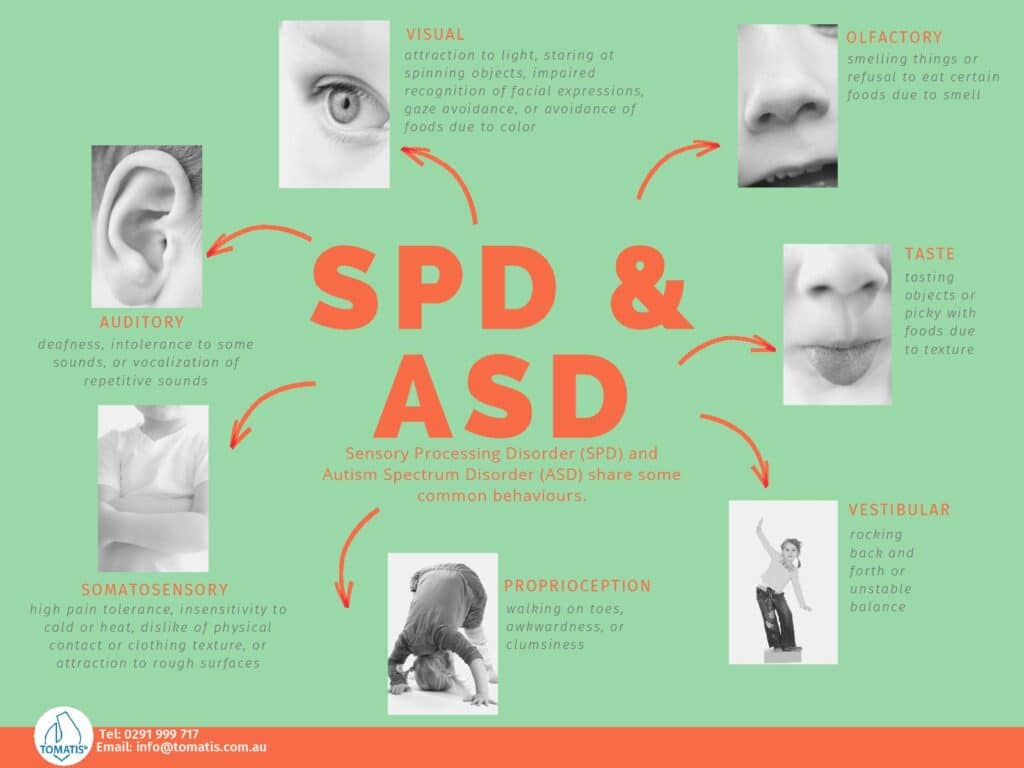
How is Sensory Processing Disorder Different From Autism?
Can your child have sensory processing disorder with autism? Yes. Sensory processing disorder may be a comorbid symptom of autism. But it does not mean that all children with sensory processing disorder are autistic. In this case, your child may only have sensory processing disorder without autism.
DSM-5 added sensory processing disorder to restrictive or repetitive behaviours, a symptom of autism. Children with autism have symptoms apart from sensory processing disorder. These include social and communication difficulties.
The best way to know if your child has sensory processing disorder and autism is through a thorough evaluation.
What is the Relationship Between Autism and Sensory Issues?
A child with a sensory processing disorder and autism exhibits extreme sensitivity to touch, sounds, temperature, smell, texture, and visual inputs.
About 5% to 16.5% of the general population have symptoms linked to sensory processing difficulties. The estimated prevalence is higher for people with autism. People with autism and sensory processing problems have a rate of about 69% to 95%.
The underlying cause is unclear. Several theories suggest a possible link between sensory dysfunction and abnormalities in the brain structure and functions related to autism.
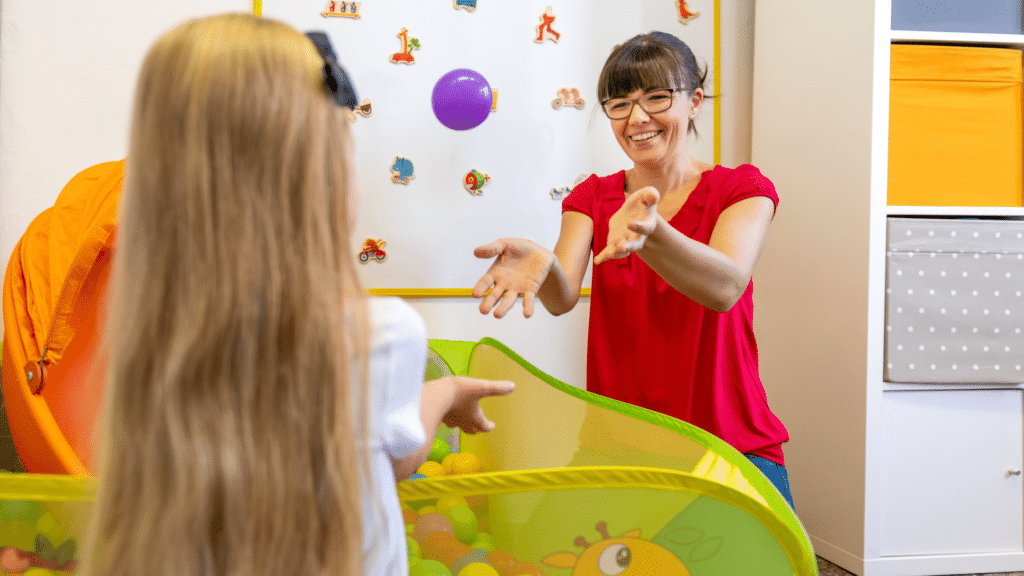
How Does the Tomatis® Method Work for Autism and Sensory Issues?
Therapists manage sensory processing disorder and autism symptoms with neurosensory training
Sensory integration therapy
Studies suggest sensory integration therapy as a core treatment of autism coupled with other interventions. A. Jean Ayres developed sensory integration therapy in the 1970s as a modality for sensory processing problems. Occupational therapists work with autistic children to stimulate sensory responses. It includes play-based bouncing, climbing, and movement activities.
Neurosensory Stimulation Training
The vestibular system, a structure in the inner ear, is vital in sensory processing. If the auditory system’s involving the cochlea for sound processing or other inner ear structures are impaired, the brain fails to process sensory inputs properly.
A study assessed the sensory profile of children with autism. The result reveals that hearing was most affected and touch was least affected in the home. In the classroom, both hearing and touch were most affected. In these settings, your child can benefit from auditory stimulation interventions.
The Tomatis® Method is a good example of neurosensory (ear-brain- body) training that improves the sound sensitivity of people with autism. It improves sound processing and reduces sound sensitivity.
Changes in balance and proprioception are evident in sensory processing disorder and emotional regulation. A child’s balance and proprioception can be compromised when there is an overwhelm of sensory stimulation.
We offer TalksUp programs at Tomatis® Australia. It is a device that allows the shift in processing in the brain and is associated with specialised headphones with both air and bone conduction. It works by creating inner filters, discriminating sounds, and blocking distractions. It helps improve balance and proprioception and self-regulation.
The Tomatis® Method is the leading choice of therapy for children with autism. It reduces autistic symptoms and stereotypical movements. And, it also improves some aspects of communication and social skills.
How will you know what works best for your child?
The crucial questions to ask yourself are the following:
- Is my child autistic?
- Does my child exhibit sensory processing disorder behaviours even if he/she has no autism?
- Does my child have autism and sensory processing disorder?
Every child like Jake, Missy, and Luca need to undergo customised interventions based on their specific conditions. Get a FREE 20-min Phone Chat with a senior clinical psychologist, Françoise Nicoloff, today to know about Tomatis® Method for your child’s sensory processing disorder and autism.
Françoise Nicoloff
Official Representative of Tomatis Developpement SA in Australia, Asia and South Pacific, Director of the Australian Tomatis® Method, Registered Psychologist, Certified Tomatis® Consultant Senior, Tomatis® International Trainer and Speaker, Co-author of the Listening Journey Series, 40 Years of Experience, Neurodiversity Speaker
